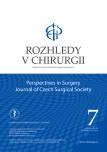Mesh fixation in laparoscopic reconstruction of inguinal hernias
Authors:
R. Čureček; Z. Adamová; O. Čech
Authors‘ workplace:
Chirurgické oddělení, Vsetínská nemocnice, a. s.
Published in:
Rozhl. Chir., 2019, roč. 98, č. 7, s. 282-286.
Category:
Original articles
Overview
Introduction: Laparoscopic inguinal hernia repair is a widely used surgical technique, although not exempt from potential complications. The aim of our study was to compare our postoperative results according to the fixation method of the prosthetic material.
Methods: This is a retrospective study. We looked up 167 patients who underwent laparoscopic inguinal hernioplasty between 01 Jan 2015 and 31 Dec 2016 at the Surgical Department of Vsetin Hospital. The patients were invited for a follow-up visit after 4−6 weeks and a questionnaire was sent them after 9−33 months. We evaluated any development of postoperative hematoma, recurrent hernia and pain after one month and during the first year from the surgery in dependence on the fixation method (stapler Pro Thick, acrylic glue Glubran, 3D light mesh).
Results: In total, 120 patients were enrolled in the study, 22 in the Glubran group, 59 in the stapler group and 39 in the 3D group. A hematoma developed in 10% in the stapler group, while there was none in the other groups; the difference was statistically significant (p=0.0382). Recurrent hernia was found in 5% in the Glubran group, 3% in the stapler group, and 0% in the 3D group; no statistically relevant difference was found. No difference was demonstrated for postoperative pain, either.
Conclusion: Long-term postoperative results after TAPP were not found to differ in recurrence rates and pain based on the used fixation material in our set of patients. The stapler was associated with a higher risk of postoperative hematoma, but it was a preferred method in all cases of large hernias.
Keywords:
inguinal hernia – Pain – recurrence – TAPP – hematoma
Sources
- Klobusicky P, Hoskovec D. Reduction of chronic post-herniotomy pain and recurrence rate. Use of the anatomical self-gripping ProGrip laparoscopic mesh in TAPP hernia repair. Preliminary results of a prospective study. Videosurgery Miniinv. 2015;10: 373–81.
- The Hernia Surge Group. International guidelines for groin hernia management. Hernia 2018; 22:1−165.
- Mayer F, Niebuhr H, Lechner M, et al. When is mesh fixation in TAPP-repair of primary inguinal hernia repair necessary? The register-based analysis of 11,230 cases. Surg Endosc. 2016;30:4363–71. doi:10.1007/s00464-016-4754-8.
- Hussain A1, Nicholls J, El-Hasani S. Technical tips following more than 2000 transabdominal preperitoneal (TAPP) repair of the groin hernia. Surg Laparosc Endosc Percutan Tech. 2010;20:384−8. doi:10.1097/SLE.0b013e3182006845.
- Neumayer L, Giobbie-Hurder A, Jonasson O, et al. Open mesh versus laparoscopic mesh repair of inguinal hernia. N Engl J Med. 2005;350:1819–27. doi:10.1056/NEJMoa040093.
- Burcharth J, Andresen K, Pommergaard H-C, et al. Recurrence patterns of direct and indirect inguinal hernias in a nationwide population in Denmark. Surgery 2014;155:173−7. doi:10.1016/j.surg.2013.06.006.
- Pokorny H, Klingler A, Schmid T, et al. Recurrence and complications after laparoscopic versus open inguinal hernia repair: results of a prospective randomized multicenter trial. Hernia 2008;12:385−9. doi:10.1007/s10029-008-0357-1.
- Soltés M, Pazinka P, Radonak J. Laparoscopic hernioplasty TAPP in treatment of groin hernia−10 years experience. Rozhl Chir. 2010;89:384−9.
- Kaul A, Hutfless S, Le H, et al. Staple versus fibrin glue fixation in laparoscopic total extraperitoneal repair of inguinal hernia: a systematic review and meta-analysis. Surg Endosc Other Interv Tech. 2012;26:1269−78. doi:10.1007/s00464-011-2025-2.
- Amato G, Agrusa A, Romano G, et al. Modified fixation free plug technique using a new 3D multilamellar implant for inguinal hernia repair: a retrospective study of a single operator case series. Hernia 2014;18:243−50. doi:10.1007/s10029-013-1102-y.
- Bell RC, Price JG. Laparoscopic inguinal hernia repair using an anatomically contoured three-dimensional mesh. Surg Endosc. 2003;17:1784−8. doi:10.1007/s00464-002-8763-4.
- Aasvang EK, Bay-Nielsen M, Kehlet H. Pain and functional impairment 6 years after inguinal herniorrhaphy. Hernia 2006;10:316−21. doi:10.1007/s10029-006-0098-y.
- Kalliomaki ML, Meyerson J, Gunnarsson U. Long-term pain after inguinal hernia repair in a population-based cohort; risk factors and interference with daily activities. Eur J Pain. 2008;12:214–25. doi:10.1016/j.ejpain.2007.05.006.
- Callesen T, Bech K, Kehlet H. Prospective study of chronic pain after hernia repair. Br J Surg. 1999;86:1528–31. doi:10.1046/j.1365-2168.1999.01320.x.
- Perkins FM, Kehlet H. Chronic pain as an outcome of surgery. A review of predictive factors. Anesthesiology 2000;93:1123–33.
- Macrae WA. Chronic pain after surgery. Br J Anaesth. 2001;87:88–98. doi:10.1093/bja/87.1.88.
- Cunningham J, Temple WJ, Mitchell P, et al. Cooperative hernia study. Pain in the postrepair patient. Ann Surg. 1996;224:598-602.
- Magnusson N, Gunnarsson U, Nordin P, et al. Reoperation for persistent pain after groin hernia surgery: a population-based study. Hernia 2015;19:45–51. doi:10.1007/s10029-014-1340-7.
- Loos MJA, Roumen RMH, Scheltinga MRM. Classifying post-herniorrhaphy pain syndromes following elective inguinal hernia repair. World J Surg. 2007;31:1760–7. doi:10.1007/s00268-007-9121-4.
- Andresen K, Fenger AQ, Burcharth J, et al. Mesh fixation methods and chronic pain after transabdominal preperitoneal (TAPP) inguinal hernia surgery: a comparsion between fibrin sealant and tacks. Surg Endosc. 2017;31:4077−84. doi:10.1007/s00464-017-5454-8.
- Beldi G, Haupt N, Ipaktchi R, et al. Postoperative hypoesthesia and pain: qualitative assessment after open and laparoscopic inguinal hernia repair. Surg Endosc. 2008;22:129–33. doi:10.1007/s00464-007-9388-4.
- Fitzgibbons RJ, Jr, Camps J, Cornet DA, et al. Laparoscopic inguinal herniorrhaphy. Results of multicenter trial. Ann Surg. 1995;221:3–13.
- Phillips EH, Arregui M, Carroll BJ, et al. Incidence of complications following laparoscopic hernioplasty. Surg Endosc. 1995;9:16–21.
Labels
Surgery Orthopaedics Trauma surgeryArticle was published in
Perspectives in Surgery

2019 Issue 7
- Metamizole vs. Tramadol in Postoperative Analgesia
- Metamizole at a Glance and in Practice – Effective Non-Opioid Analgesic for All Ages
- Possibilities of Using Metamizole in the Treatment of Acute Primary Headaches
Most read in this issue
- The most recent recommendations for the surgical treatment of inguinal hernia
- Mesh fixation in laparoscopic reconstruction of inguinal hernias
- Fournier‘s gangrene as Amyand‘s hernia complication
- Fistuloclysis as a method of nutritional management in a patient with high output enteroatmospheric fistula – a case report
